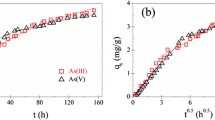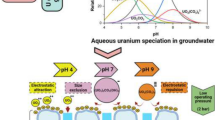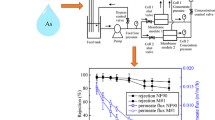Abstract
A laboratory-scale investigation was performed to study arsenic (As (V)) removal by negatively charged GE-HL nanofiltration (NF) membrane in simulated drinking water. Effects of As (V) concentration (0–200 μg·L−1), pH, and co-ions and counter-ions were investigated. The NF membrane presented good stability, and the rejection rates exceeded 90%. The rejection rates of As (V) decreased with the increase of As (V) concentration, while it increased with the increase of pH (reached 96% at pH 6.75). Moreover, a negative relationship was observed between the co-existing ions of Cl−, Na+, SO 2−4 , and Ca2+ and the removal of As (V), in which bivalent ions presented more significant effects than monovalent ions.
Similar content being viewed by others
References
Thomas S Y C, Chuah T G, Robiah Y, Gregory Koay F L, Azni I. Arsenic toxicity, health hazards and removal techniques from water: An overview. Desalination, 2007, 217(1–3): 139–166
Davis T A, Volesky B, Mucci A. A review of the biochemistry of heavy metal biosorption by brown algae. Water Research, 2003, 37(18): 4311–4330
Bhattacharya P, Welch A H, Ahmed K M. Arsenic in groundwater of sedimentary aquifers. Applied Geochemistry, 2004, 19: 163–167
Sheng J X, Bing Z D, Qiao L Z. Study of arsenic removal by nanofiltration and its application in China. Desalination, 2007, 204(1–3): 374–379
Doshi H, Ray A, Kothari I L. Live and dead spirulina sp. to remove arsenic (V) from water. International Journal of Phytoremediation, 2009, 11(1): 53–64
Lee Y, Um I H, Yoon J. Arsenic (III) oxidation by iron (VI) (ferrate) and subsequent removal of arsenic (V) by iron (III) coagulation. Environmental Science and Technology, 2003, 37(24): 5750–5756
Bissen M, Frimmel F H. Arsenic-A review. Part II: Oxidation of arsenic and its removal in water treatment. Acta Hydrochimica et Hydrobiologica, 2003, 31(2): 97–107
NSF International. Environmental Technology Verification Report: Removal of Arsenic in Drinking Water. Prepared for USEPA, 2001
Ning R Y. Arsenic removal by reverse osmosis. Desalination, 2002, 143(3): 237–241
Ruggieri F, Marín V, Gimeno D. Application of zeolitic volcanic rocks for arsenic removal from water. Engineering Geology, 2008, 101: 245–250
Brandhube P, Amy G. Arsenic removal by a charged ultrafiltration membrane-Influences of membrane operating conditions and water quality on arsenic rejection. Desalination, 2001, 140(1): 1–14
Sato Y, Kang M, Kamei T, Magara Y. Performance of nanofiltration for arsenic removal. Water Research, 2002, 36(13): 3371–3377
Waypa J J, Elimelech M, Hering J G. Arsenic removal by RO and NF membranes. Journal of American Water Works Association, 1997, 89(10): 102–114
Brandhuber P, Amy G. Alternative methods for membrane filtration of arsenic from drinking water. Desalination, 1998, 117: 1–10
Wang XW, Liu W J, Li D S. Selective removal of Cl−/F− by GE-HL nanofiltration application to the defluorination of groundwater. In: The National Advanced Treatment Conference for Drinking Water of 2008 Annual Meeting, Shenzhen: China Civil Engineering Society, 2008 (in Chinese)
Coronell O, Mariñas B J, Zhang X J, Cahill D G. Quantification of functional groups and modeling of their ionization behavior in the active layer of FT30 reverse osmosis membrane. Environmental Science and Technology, 2008, 42(14): 5260–5266
Vroenhoek E M, Waypa J J. Arsenic removal from drinking water by a “loose” nanofiltration membrane. Desalination, 2000, 130(3): 265–277
Uddin M T, Mozumder M S I. Nanofiltration membrane process for the removal of arsenic from drinking water. Chemical Engineering & Technology, 2007, 30(9): 1248–1254
Ayoob S, Gupta A K, Bhat V T. A conceptual overview on sustainable technologies for the defluoridation of drinking water. Critical Reviews in Environmental Science and Technology, 2008, 38: 401–470
Lohokare H R. Muthu M R, Agarwal G P, Kharul U K. Effective arsenic removal using polyacrylonitrile-based ultrafiltration (UF) membrane. Journal of Membrane Science, 2008, 320(1–2): 159–166
Wang L, Wang B Z. The Advanced Treatment Technology in Drinking Water. Beijing: Chemical Industry Press, 2002 (in Chinese)
Author information
Authors and Affiliations
Corresponding author
Rights and permissions
About this article
Cite this article
Wang, X., Liu, W., Li, D. et al. Arsenic (V) removal from groundwater by GE-HL nanofiltration membrane: effects of arsenic concentration, pH, and co-existing ions. Front. Environ. Sci. Eng. China 3, 428–433 (2009). https://doi.org/10.1007/s11783-009-0146-9
Received:
Accepted:
Published:
Issue Date:
DOI: https://doi.org/10.1007/s11783-009-0146-9




